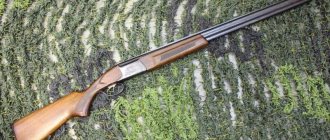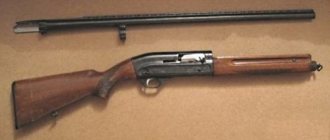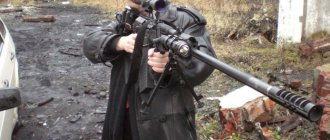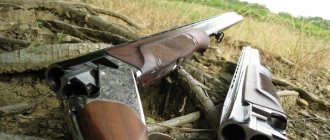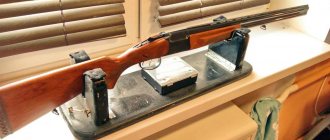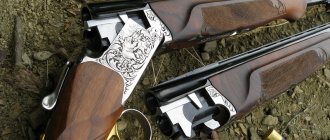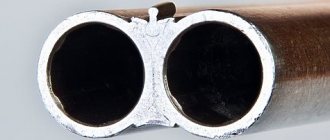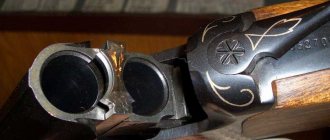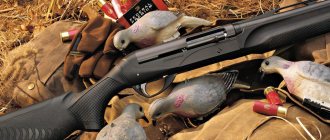- November 15, 2018
- Weapons and ammunition
- Natali Michaelis
Even during the times of Tsarist Russia, the activities of industrial hunters in the Far East and Siberia brought the state quite a large income. With the advent of Soviet power, the specifics of the activity did not change much, but there was a need to use certain weapons for various game. Because of this, hunters had to take both a shotgun and a rifle with them on a hike. To make the work of fishermen easier, a special combining model of the Belka gun was developed.
History of creation
During the Great Patriotic War, all arms factories concentrated their efforts on the production and improvement of samples suitable for the front. Over the years, engineers and workers have accumulated extensive experience in creating weapons. After the victory in World War II, the size of the Soviet army was significantly reduced. After this, gunsmiths had the opportunity to pay attention to the needs of the common population, in particular, commercial hunters, since the extraction of fur-bearing animals was still carried out with the help of small guns and shotguns.
It was quite impractical to take two weapons with you on a hunt at once, so Soviet gunsmiths faced a difficult task. It was necessary to develop a fundamentally new model of firearms that could fire both shot and bullet. In addition, such weapons had to be easy to use and also be inexpensive.
The development of IZH-56 (“Belka”) began in the mid-50s of the last century. The engineers planned to create a bullet-shot weapon with twin barrels. A few years later, a real work of art in weapons craft appeared before Russian hunters.
Sleeves
Click on the image to enlarge... CASES FOR HUNTING SMOOTHBORE RIFLES
Casings are a necessary accessory for every breech-loading shotgun.
The size and quality of the capsule, the care taken in making the socket into which the capsule is inserted, the strength and tightness of the walls of the cartridge case, the overall dimensions of the cartridge case and the correctness of their calibration - all this affects the quality of the shot, as well as the service life of the gun.
Currently, our factories produce the following cartridges for shotguns:
- hunting metal cartridges of 12, 16, 20, 24, 28 and 32 calibers, 70 and 65 mm long;
- hunting paper (folder) cartridges of 12, 16 and 20 calibers, 70 and 65 mm long.
Paper cartridges are made for a closed capsule and for an ordinary open hunting capsule “Tsentroboy”.
Sleeves serve to combine and protect from atmospheric influences all elements of a loaded hunting cartridge.
A metal hunting cartridge case (Fig. 209) is a seamless tube, the bottom of which has a flange (or side) and a socket (for inserting an open capsule) with a stamped anvil and three ignition (or seed) holes.
A paper hunting cartridge case (Fig. 211) is a paper tube rolled up in several layers, one end of which is open, and a metal head is firmly attached to the other, which has a socket for the capsule and anvil in the center.
The metal head with the paper tube is press-fitted using a paper wad, which is called the case base wad.
As can be seen in Fig.
211, a paper sleeve for an ordinary “Tsentroboy” capsule also has an anvil, which is a metal comb with a shank, with which it is inserted into the hole of the capsule socket. Rice. 209. Metal seamless sleeve for shotguns: 1 - wall; 2 - bottom or cap; 3 - dulce; 4 - capsule socket; 5 - anvil; 6 - seed or ignition holes; 7 - edge or side
Rice. 210. Paper sleeve for shotguns under the “Zhevelo” primer: 1 — paper tube; 2 - metal head; 3 - bottom; 4 - dulce; 5 - capsule socket; 6 - edge or side; 7 - paper wad of the base of the sleeve Fig.
211. Paper sleeve for shotguns with an anvil for an open primer of the central fire: 1 - paper tube (case wall); 2 - metal head; 3 - bottom; 4 - dulce; 5 - capsule socket; 6 - anvil; 7 - edge or side; 8 - paper wad of the case base. In each box with cartridges under the open primer of the central fire, at least 140 anvils (for 100 pieces of cartridges) are placed in a separate bag.
Metal and paper casings for an open, ordinary “Central Shot” primer are intended for firing shot and bullet from hunting smoothbore rifles using black powder; paper cartridges with a capsule socket for a closed Zhevelo capsule, which has an anvil embedded inside, for firing smokeless powder (Fig. 210).
Both paper and metal sleeves have positive and negative properties.
Metal (brass) shells for shotguns have two positive qualities compared to paper ones: firstly, efficiency (a metal shell can be loaded several tens or even hundreds of times), and secondly, strength (they are moisture resistant, their dimensions change little under exposure to dampness, and these sleeves are not permeable to gases).
Negative properties of metal sleeves:
- they are heavy;
- it is impossible to hold shot in them with a light shot wad, which is most suitable for achieving a better fight;
- It is not recommended to fire smokeless powder from them;
- they do not fit so tightly to the walls of the chamber during a shot at relatively low pressures of powder gases (300-400 atm).
In turn, paper cartridges quickly become wet, swell and do not fit into the chamber of the gun. As a rule, they can withstand no more than two shots.
But paper cartridges are good because they make it possible to use smokeless powder and a light shot wad. And this ensures high shot flight speeds and increases other ballistic indicators.
Every shotgun shooter needs to learn the following.
- The main principle of shotgun ballistics is that the more accurately the channels of the cartridge case and the barrel coincide at the moment of the shot, the better the quality of the shot will be. On the contrary, the smaller this coincidence, the greater fluctuations in the firing of the gun should be expected from shot to shot in the number of pellets hitting the target, as well as in the uniformity of their distribution on the target.
In addition, a case bore that is too wide leads to an increase in gas pressure, which is not always safe for the gun, especially with fast-burning (sharp) varieties of smokeless powder.
- The diameter of the cartridge case must correspond to the chamber of the gun. A case that is too loose allows gases to escape through the chamber, reduces ballistic performance (velocity, accuracy, etc.) and covers the block and mechanism of the gun with soot.
- The primer must fit tightly into the sleeve socket. If the primer is poorly fitted, gases break through the primer socket, contaminate the firing pins and that part of the block into which the bottom of the cartridge case rests, and in hammerless guns they even get into the striking mechanism.
- The cartridge case must fit freely into the chamber. All tight-fitting cartridges loosen the bolt and damage the extractor. They especially quickly wear out the ejector of the gun and even lead to breakdown of the ejector mechanism. In addition, such cartridges slow down the rate of fire and cause delays when firing.
- The diameter of the rim (side) of the cartridge case must fit freely into the rim (recess under the case head) of the chamber. A case bottom that is too thick does not allow the bolt to accurately place the barrels in place, and rims that are too thin (small in diameter) lead to cartridges sinking, prolonged shots and even misfires, especially in guns with a short firing pin stroke.
ABOUT THE CORRESPONDENCE OF THE LENGTH OF THE CASE TO THE LENGTH OF THE CHAMBER
For shooting to be successful, the cartridge case - metal or paper - must be slightly shorter than the chamber. Otherwise, the gun will give a strong push to the shoulder, and the shot will be defective.
Many hunters, wanting to measure the length of the chamber in their gun, usually make mistakes:
- or they measure it using a metal sleeve, while forgetting about the gentle transition from the chamber to the bore;
- or they measure it with a cartridge loaded into a folder sleeve, losing sight of the fact that a 70 mm cartridge after twisting the free edge of the sleeve has a length of only 64-65 mm.
In order to accurately measure the length of the chamber, you need to make a cast from cutting sulfur, wax or paraffin. It should be borne in mind that wax and paraffin wrinkle easily when they are pushed out of the chamber, as well as during the measurement process.
The cast is made like this: a thin layer of gun oil is applied to the chamber and the beginning of the barrel behind the chamber by about 30-50 mm. Then, from the side of the muzzle to the border of the lubricated area, a felt wad 2 calibers larger than the size of the bore is inserted.
After this, molten sulfur, wax or paraffin is poured into the chamber.
The barrels with the filled mass are cooled for some time in a vertical position. When the cast has hardened, it is pushed out (from the barrel) and measured to the nearest 0.1 mm *.
- * In the absence of an appropriate tool, measurements can be made with a scale or metal ruler with an accuracy of 0.5 mm.
The paper sleeve (not twisted) should be 0.5-1.0 mm shorter than the chamber, since when fired, its tube is somewhat stretched.
An excessively long cartridge case enters the chamber with difficulty, leads to a sharp increase in the pressure of the powder gases, which greatly compress the projectile and the powder wad on the slope from the chamber to the bore, and spoils the battle.
When fired, a long, non-chambered, folder case unfolds a curled edge, lies on the slope from the chamber to the barrel bore and thus compresses, rearranges the shot shell and deforms the powder wad, as a result of which cartridge cases break through between the walls of the barrel bore and the wad, compressed by the barrel powder gases.
As a result, the flight speed of the shot decreases and the pellet of the shot shell deteriorates. Sometimes the shot sticks together into a lump. This happens especially often with soft, unheated shot with a specific gravity of 11.25-11.30.
If the powder wad and projectile are excessively compressed, as shown in Fig. 212, the pressure of powder gases in the 12th caliber increases as follows: with black powder - by 40-50 atm, with smokeless powder - by 70-100 atm. In 16- and 20-gauge guns, this difference (with smokeless powder) reaches 150 atm or even more.
Rice.
212. A - a sleeve of normal length along the chamber of a gun (a sleeve 65 mm long, a chamber 65 mm long): I - before the shot; II - at the beginning of the shot; B - the sleeve is too long, not in the chamber (the chamber is 65 mm long, the sleeve is 70 mm); III - before firing - the length of the twisted cartridge is 65 mm, it fits freely into the chamber; IV - at the beginning of the shot, the muzzle of the cartridge case, compressed by the slope, compresses the wads and rearranges the shot: in this case, the pressure of the powder gases sharply increases and the pellet of the shot shell worsens as a result of the breakthrough of powder gases into the projectile. In the event that the cartridge case is shorter than the chamber by more than the thickness of the gases compressed at shot of a powder wad, then the battle also worsens, as gases break into the shot shell (Fig. 213).
True, in this case, the deterioration of the ballistic parameters of the shot does not pose a threat to the strength of the gun, but it sharply reduces the consistency and sharpness of the battle. Rice. 213. An excessively short cartridge case, not in the chamber, causes a breakthrough of powder gases into the shot shell at the beginning of the shot, which leads to a deterioration in the engagement - it reduces the accuracy, sharpness and consistency of the engagement from shot to shot, but the pressure in the chamber does not increase CASE DIMENSIONS At the bottom of the cartridge case stamps are applied - numbers or letters - which indicate the caliber, year of manufacture and brand or name of the plant (Fig. 214, a and b).
Rice.
214. a - dimensions of metal cartridges for shotguns according to OST 40168; b - stamps on the bottom of metal cartridges: 12 - gauge; 45 and 46 - year of manufacture The best material for sleeves is brass. Brass cartridges can withstand more than 50 (up to 100) shots if handled carefully during reloading.
Iron cartridges suffer from significant disadvantages. Due to less elasticity, the fit of the walls of the iron case to the walls of the chamber is less dense at the moment of firing, which is why a more significant breakthrough of gases back occurs. Iron cartridges, as a rule, after four to five shots develop longitudinal cracks in the tube and become unusable. Iron cartridges are more susceptible to oxidation under the influence of moisture and explosive decomposition products of gunpowder and primer.
When fired repeatedly, brass cartridges, especially in the front, swell noticeably.
Therefore, before equipping, the sleeves must be calibrated by passing them through the calibration ring (Fig. 215). The same must be done if they use cartridges that were fired from another gun, especially one with wider chambers. Rice. 215. Calibration ring for metal sleeves (to table 25)
| TABLE 25. SIZES AND CALIBERS OF RINGS (to Fig. 215) | ||
| Caliber | Dimensions in mm | |
| B | C | |
| 12 | 20,50 | 20,15 |
| 16 | 19,00 | 18,80 |
| 20 | 17,60 | 17,30 |
| 24 | 16,65 | 16,40 |
| 28 | 15,75 | 15,50 |
| 32c | 13,45 | 13,25 |
Cleaned cartridges, lightly lubricated with machine or gun oil, are driven through the ring with light blows of a wooden hammer and pushed out of the ring by blows of the hammer on a wooden stick or metal rod.
Brass oxidized cartridges (covered with green spots) are cleaned of carbon deposits in leaven grounds, washed with warm water, and then wiped dry and stored in a dry place.
Rice. 216. Dimensions of paper cartridges for shotguns according to OST 40169: a - paper sleeve for the Zhevelo primer; b - paper sleeve for the open primer of the central fire; c — anvil to the paper sleeve under the open primer of the central fire; g - stamps on the bottom of paper sleeves: 12 - caliber, 50 - year of manufacture
| TABLE 26a. DIMENSIONS OF METAL CELLS ACCORDING TO OST 40168 (to Fig. 214) | ||||||
| Caliber | Dimensions in mm | |||||
| A | B | C | h | Sleeve length L | ||
| normal | elongated | |||||
| 12 | 22,45 | 20,60 | 20,20 | 1,80 | 65 | 70 |
| 16 | 20,65 | 18,85 | 18,55 | 1,55 | 65 | 70 |
| 20 | 19,40 | 17,70 | 17,25 | 1,50 | 65 | 70 |
| 24 | 18,35 | 16,75 | 16,45 | 1,50 | 65 | 70 |
| 28 | 17,40 | 15,85 | 15,55 | 1,50 | 65 | 70 |
| 32c | 15,75 | 13,55 | 13,30 | 1,50 | 65 | 70 |
| TABLE 26b. DIMENSIONS OF PAPER CASES ACCORDING TO OST 40169 (to Fig. 216) | ||||||||
| Caliber | Dimensions in mm | |||||||
| A | B | C | F | D | h | Sleeve length L | ||
| normal | elongated | |||||||
| 12 | 22,45 | 20,60 | 20,35 | 18,65 | 20,25 | 1,80 | 65 | 70 |
| 16 | 20,65 | 18,85 | 18,70 | 17,00 | 18,60 | 1,55 | 65 | 70 |
| 20 | 19,40 | 17,70 | 17,50 | 15,80 | 17,40 | 1,50 | 65 | 70 |
| 24 | 18,35 | 16,75 | 16,60 | 14,90 | 16,50 | 1,50 | 65 | 70 |
Original: https://www.sportguns.ru/
Description
The IZH-56 “Belka” shotgun is one of the most famous sideflint variants. In this double-barreled shotgun, the barrels are located in a vertical plane, which allows for more accurate shooting, unlike horizontal guns. Soldering is used for connection. The breech and muzzle parts are equipped with special couplings that play a huge role in the connection. The upper barrel is smooth, designed to use a 32 or 28 caliber cartridge loaded with shot. The lower barrel fires a lead bullet.
To lock the receivers, a special mechanism is used, which is very similar to the rifle models of the Kazan Arms Plant. However, IZH-56, unlike other vertical and horizontal guns, is equipped with one firing mechanism, not two. This design innovation was created specifically to simplify the process of operating the gun, as well as reduce the cost of production.
Development
To make the IZH-56 barrels, the developers used special 50A grade weapons steel. This alloy has fairly good ductility and strength. To ensure that the entire length of the barrel did not lose these characteristics, the metal was subjected to heat treatment.
In the small arms of the Kazan Arms Plant, special brass soldering was used to connect the barrels together. Since the IZH-56 is equipped with hardened barrels, it is simply impossible to repeat such technology. Therefore, a press fit was used to attach the handguard, swivel and couplings to the post. In addition, all samples are equipped with smooth pins that protect the trunks from possible displacement during planting.
In 1956, a 32-caliber barrel was manufactured at the Izhevsk Arms Plant. For this purpose, a special cylindrical drill with a Paradox choke was used. Thanks to this narrowing, the weapon showed excellent results during field tests when firing a bullet. But the rifled barrel had the opposite effect. Engineers noted that at a distance of more than 35 meters, not all the shot, but about 35% of the charge, hits the target, whose diameter is 75 cm. Therefore, it was decided not to use the Paradox system during the creation of rifled barrels.
History of appearance
The 32-caliber Deer shotgun was designed in such a way that the smooth barrel was intended for hunting upland game and fur-bearing animals. From the second barrel, which had a Paradox type drill, they shot at ungulates. But this was considered possible only when at a distance of one hundred meters the spread of bullets did not exceed fifteen centimeters.
Unfortunately, the gunsmiths were unable to achieve this, but over a two-year period, 200 products with rifled barrels and one thousand Olen guns with drilling were produced.
As soon as the 32 mm caliber sample appeared on retail shelves and began to sell out, it turned out that the Olen gun’s accuracy with bullet ammunition left much to be desired. Experts claim that this was the main reason why the plant stopped production of such weapons.
The owners began to modify 32-caliber Olen brand guns privately, working in two directions. Some of the hunters installed an additional coupling, some limited themselves to soldering the barrel part along the entire length. There are cases when a new fore-end was added to the soldering joint. These measures made it possible to increase the operational period of the 32 mm Olen rifle to four years. The main objective of such changes was to make the system more rigid and reduce bullet spread.
As follows from the reviews, when firing from a hundred meters, bullet charges fell into a circle whose diameter did not exceed ten centimeters. It is fair to say that such improvements were only available to people with the necessary skills.
There was a second option for improving the accuracy of the battle. In this case, a more efficient bullet was used compared to the one offered by the manufacturer of the 32 caliber hunting rifle. According to experts, during the experiment the trunks thickened and their length shortened to 56 and 60 cm.
In addition to modernizing the 32 mm caliber weapon itself, experiments were also carried out with charges for it. Initially, it was noted that even without modifying the barrels, a homemade bullet when fired gave better accuracy results than a factory-cast one. But these observations were noted only among hunters; official data confirming the peculiarity of the use of ammunition were first published in 1977. It was then that it was proposed to use a ogive-type cylinder bullet for the lower barrel, cast in a special split-type bullet. It was recommended to use molten shot as a starting material for casting bullets.
It was possible to install optics
Specifications
The 32 caliber shotgun "Belka" has the following technical characteristics:
- weight – 3 kilograms;
- lower barrel caliber – 32 millimeters;
- upper barrel caliber – 5.6 millimeters;
- length – 65 centimeters;
- type – trigger-type combination gun;
- country of origin - USSR.
More detailed information can be obtained from the weapons passport, which is necessarily included in the kit along with the operating instructions. The description and characteristics of the IZH-56 “Belka” hunting rifle allow us to judge the effectiveness of this weapon exclusively for hunting purposes. Buying such a unit for self-defense purposes or for shooting training is almost pointless.
Advantages of 32 caliber
Most Russian hunters believe that 12-gauge cartridges are universal, since they can be used to shoot both large predators (for example, a bear) and fur or feathered game. However, if we consider 32-caliber ammunition as a highly specialized projectile, it will have a significant list of positive qualities, which are very difficult to disagree with:
- Light weight of weapons and ammunition. At first glance, the difference of 500-700 grams is not significant. However, many hunters who walked several tens of kilometers in search of prey especially valued 32-caliber shotguns, since they often weigh up to 3 kg when loaded. An easy-to-lift weapon guarantees high maneuverability while aiming (especially important in case of sudden appearance of game).
- Slight recoil and gunshot sound. It's very simple - the less gunpowder in the cartridge, the less muzzle energy will be generated at the moment of the shot. Accordingly, the level of noise and recoil will also be noticeably lower than that of 12-gauge cartridges. These nuances are especially appreciated by hunters who hunt migratory game. Well, the absence of bruises in the shoulder area will be a pleasant addition for any fisherman.
- Appropriateness. A very important factor, closely related to the weight and dimensions of the weapon. When raised, the 32-caliber gun quite quickly rests with the butt of the butt on the shoulder, and is also aimed precisely at the target in a split second. Of course, a lot depends on the hunter’s physique. However, it should be noted that 32-caliber shotguns do not require a long time to adjust the line of fire, and accordingly, hunting efficiency increases.
- High accuracy of combat. Especially if you load the cartridge with the largest possible shot 0000 - 4 pieces in 4 rows. This parameter is also closely related to the mass of the powder charge. The less gunpowder in the projectile, the less its sharpness, but the higher the accuracy of the fire when shooting with shot. But this feature is typical only when shooting at a short distance (at a distance of more than 40 meters, the projectile scatters to the sides).
High accuracy of combat is a positive side of 32 caliber shotguns. - Covering a large impact area. Now imagine that you loaded a 32 caliber cartridge with the smallest shot and fired from a distance of 50-60 meters. No gun will cover a large impact area. This is why professional hunters value the 32 caliber so much when hunting feathered and fast-moving game, such as a hare or duck. The main thing is to calculate the optimal accuracy indicator.
- Economical. Although the difference of a few rubles may seem insignificant to some, it is still less than the cost of 12 or 20 gauge cartridges. If you load the cartridges yourself, then they will cost pennies, because the amount of gunpowder and shot that can be placed in a narrow cartridge case is very small. The benefits will be especially obvious when using the .32 for target practice.
- Small dimensions of the gun. A particularly important parameter for those who prefer to make their way to hunting grounds on their own, bypassing thickets of vegetation and swamps. A .32 caliber shotgun is very easy to handle in winter, because it will not cling to the hunter’s thick layer of clothing. Also, the relatively small dimensions allow you to install an unlimited amount of “body kit” on the weapon (optics, laser target, belt, etc.).
Weapon system elements
The IZH-56 “Belka” combination shotgun consists of the following components:
- trigger mechanism;
- receiver;
- a rotary lever that locks the barrels;
- switch;
- descent;
- trigger
Despite the fact that the weapon is a combination weapon, it has a fairly simple design. Even a novice hunter can handle partial disassembly, so carrying out repair and lubrication work will not be difficult at home.
Design
Due to the fact that this hunting rifle is based on the ZKM 1, many characteristics of the Olen’s elements are reminiscent of its predecessor. For example, the design of the fore-end, stock and locking mechanism are completely copied from a single-shot shotgun. The trigger mechanism is located in the block. The spring is compressed by cocking the external trigger with a safety cock, designed for two barrels. The Deer shotgun has a single trigger, which can be switched between barrels by operating a push-button switch located in the usual place for the safety control element. By moving the switch, you can move the trigger forward or backward. In the first case, it will be installed above the upper striker, in the second - above the lower one, at a slight angle. It is possible to switch the trigger between barrels when the hammer is cocked or when the safety is on.
It should be noted that when the Olen brand gun is set to safety, the shot does not occur even with the barrels unlocked. In addition, the trigger and locking lever are interlocking. Simply put, if the hammer is cocked, then the barrel opening lever is blocked, and when the release lever is pressed, the hammer will no longer be cocked.
Pressing the trigger implies a force of 1.5 - 3 kg; there is no data on it in the product passport, but it is possible to make the adjustment yourself.
At the moment of breaking the .32 caliber Deer gun, the common ejector removes two cartridges, for which it is necessary to press the lever up until it stops. It moves quite rigidly, but is located comfortably and does not cause any discomfort when used. In addition, a certain rigidity in the process guarantees that spontaneous opening during transportation will not occur.
The Deer shotgun does not have a reliable design. It has simple characteristics, but its survivability leaves much to be desired. Since the weapon is based on a single-barrel version of the Kazan, the locking system becomes loose quite quickly. And the shaft of the barrels is considered a critical characteristic when shooting bullets. In addition, the trunks are reinforced with couplings and have the ability to vibrate and cross.
The initial velocity of a bullet fired from a Deer gun is quite low - up to 310 m/s. The conclusion suggests itself that with such characteristics of the Deer gun, going on a hunt for a large animal is a dubious idea even for such a 32-caliber hunting rifle.
Since 1956, serial production of the commercial model began
Features of the barrel device
Thanks to heat treatment, the shot barrel is quite durable, despite the reduced wall thickness. Besides. engineers managed to reduce the weight of the weapon itself by reducing the weight of the barrel.
The rifled barrel is designed to use 5.6 mm ammunition. Why were these particular cartridges chosen? The fact is that during the years of creation of the Belka combination shotgun, these cartridges were produced in large quantities and were used by most small-caliber rifles, as well as Tula Margolin pistols. Each owner of IZH-56 did not have to worry about not being able to purchase the required amount of ammunition. In addition, such cartridges were and still are much cheaper than branded counterparts. When testing weapons using 5.6 caliber, fairly good results were achieved that satisfied all the requirements and hopes placed on them. The expert commission found that this cartridge is best suited for hunting small fur-bearing animals.
Advantages and disadvantages
To present all the positive and negative aspects of the Deer gun, you can refer to the numerous reviews of hunting fans who have had to deal with it.
For example, one of the negative characteristics is the use of a brass sleeve, which today is considered very rare. The shot load is small - up to 18 g; large size (00) is not recommended. The sharpness and accuracy characteristics of the Olen brand gun leave much to be desired. You can take hazel grouse, marten and squirrel, but you cannot take a hare, wood grouse or fox with this weapon.
Industrially made bullets are terribly baptized - you have to install an additional clamp on the barrel block.
Another inconvenience of the design of the 32-caliber Deer shotgun is that cocking is carried out immediately before shooting. In addition, the bullets have to be cast independently.
As positive aspects, owners of Olen guns note the possibility of their modification in order to improve the quality characteristics of accuracy. The 32-caliber Deer shotgun is also distinguished by its simplicity of design, maintainability and replaceability of parts. The weapon fits comfortably and accurately into the shoulder.
Principle of operation
The 32-caliber Belka shotgun, a photo of which can be found in the review, has only one trigger, unlike horizontal and vertical double-barreled guns. In the receiver there is a vertical groove in which the trigger switch is located. It works on the principle of intermediate traction. The barrel is locked using a locking pin. To move the button at the rear of the receiver to the desired position, you must first press the pin.
If the button is in the rear position, the trigger will interact with the lower striker, and if it is in the front position, with the upper one. Also, this button not only serves as a trigger switch, but also affects the rotating rear sight, namely, it regulates its position. So that gun owners could zero in on their own, the designers decided to install the rear sight on a special base, which is adapted for lateral movement. To do this, you need to interact with a special groove. The inside of the receiver became the location of the mechanism itself, which is responsible for moving the rear sight.
How to load a weapon?
To load the IZH-56 “Belka” shotgun, the photo of which is presented to your attention, you don’t have to make any special efforts. It will only be enough to perform a few sequential steps.
- We press the trigger lever, which is located at the bottom of the receiver.
- We press down on the trunks from above (it is recommended to place the emphasis strictly in the middle).
- After opening the carbine, you need to insert ammunition into it.
- Press the lever again and smoothly close the gun.
- We cock the trigger.
After this, all that remains is to remove the weapon from the safety and fire a few shots. Remember to follow safety rules while recharging. For example, never point the barrel down or towards bystanders.
First option
The first of the varieties was designed back in 1956 under the leadership of engineer A. A. Klimov. The 28-caliber Belka combination shotgun was equipped with only one trigger. Using a special mechanism, the hunter could easily switch between barrels, depending on what kind of game was being hunted. If it was necessary to fire from the upper barrel, it was enough to direct the position of the lever forward. If there was a need to fire a shot from a rifled barrel, the switch was moved back. All these actions were quite simply performed both with the trigger pulled and cocked.
Since the trunks were located in a vertical plane, there was a possibility of their disconnection from each other. If necessary, it was possible to replace the old barrel with a new one. To do this, the forend was first disconnected, which was secured using a special latch. After this, it was possible to disconnect the trunks from each other. To ensure that the weapon did not vibrate during shooting and had maximum accuracy, three couplings were used to secure the barrels.
Judging by the feedback from hunters, the cartridge ejector created some inconvenience if the hunter wanted to remove them himself. However, this mechanism significantly simplified the operation of the Belka. The IZH-56 "Belka" shotgun had a smoothbore barrel length of 65 and 72 centimeters for 28 and 32 calibers. The lower barrel was slightly shorter - 45 centimeters and assumed the use of 5.6 mm ammunition. The difference in barrel length could be more than compensated for by an additional cylindrical tube attached to the weapon. Over time, it became a continuation of the rifled barrel.
The weight of “Squirrel” was about 3.15 kilograms. According to reviews from professional hunters, this model has proven itself only from the best side. The weapon is still considered universal for hunting fur-bearing animals and birds. The presence of combined shafts significantly simplifies fishing activities.
Single-barreled 32 caliber. External hammer models IZH-ZK – IZHK
Photo by Andrey Chugin.
Continued article - HERE
The proliferation of hunting weapons of one caliber or another determines their capabilities in hunting.
The advantages of 12-gauge shotguns, which have large shot shells, are obvious.
But not all hunters need so much shot in one cartridge; many want to shoot from small-caliber guns.
Smooth-bore 32-caliber guns are few in number, but are invariably popular among feather hunting enthusiasts.
The need for single shots of this caliber is small, and you need to skillfully shoot from such a small gun with a small amount of shot.
But in our country, with inaccessible but game-rich lands, 32-caliber shotguns are common due to their economical caliber.
Game expert, Ph.D. agricultural Sciences V.A. Kukartsev told how in the 20th century in the north of the Khanty-Mansiysk Okrug, local residents killed moose with one shot from small-caliber rifles, getting close to them and shooting at the only killing place accessible to such a small weapon.
Such hunting is only possible for local hereditary hunters who are well aware of the habits of animals and their lands. There they valued single-barreled 32-caliber rifles with a folding barrel.
In the taiga V.A. Kukartsev himself hunted a lot with a 32-caliber double-barreled shotgun - the now rare Zlatoust hammer-operated vertical double "Deer", created on the basis of the external hammer single-barrel ZK system of V.A. Kazantseva.
I also hunted with 32-caliber shotguns, starting with a single-shot model with a S.I. bolt action. Mosin, later with other shotguns, the small hammer-fired double-barreled TOZ-54 32-caliber shotgun was desirable. Undoubtedly, the usual destiny of .32-caliber shotguns is small game.
Izhevsk 32-caliber breech-loading single-barrel guns are varied and numerous; a full overview requires a lot of space, so first about the group of external trigger single-barrel guns IZH-ZK–IZHK–IZH-17, including the evolution of these models.
Single-barrel 32-caliber guns were equipped with a barrel with a nominal bore diameter of 12.5 mm, this value is indicated in the “Passports”; Of course, it is advisable for hunters to measure the actual bore diameter.
Read the article “The Guns We Lost”
Later, the 32-caliber barrel was provided with a bore ranging from 12.7–13.1 mm in diameter, usually 12.7 mm.
Domestic factories produce only metal, more precisely brass, 32-caliber cases, 70 mm long, with an outer diameter at the muzzle of 13.25 mm with a tolerance of -0.2 mm and an inner diameter of 12.35 with a tolerance of +0.4 mm. Of course, the cartridges, like the chambers, are conical in length.
Brass sleeves of 32 caliber are made for a “centrifugal” capsule with a stamped anvil, and since 1977, for a “gevelo” capsule with a through cell.
To reload metal cartridges, a massive calibration ring is required; it can be machined exactly to fit the chamber of your own gun. 32-caliber wads are also produced; there is everything to equip such cartridges.
Nowadays, a wide variety of guns, including 32 caliber, are coming to our market from abroad. Our hunters should remember the differences in the chambers of 32-caliber shotguns of domestic and foreign production.
Taking into account the taper, the diameter of the chambers of our 32-caliber smooth-bore shotguns is 13.3–13.55 mm, while foreign ones are 14.3–14.6 mm. Domestic cartridges are noticeably smaller and in foreign 32-caliber guns they actually fall into the chambers, while foreign cartridges do not fit into the narrow chambers of our guns at all.
Foreign 32-caliber cartridges with paper shells are convenient for simple equipment using a twist, but the 32-caliber is the only one in which domestic and foreign cartridges are not interchangeable.
At one time, I also had to abandon the European hammer-fired double-barreled shotgun, as my supply of foreign 32-caliber cartridges with paper shells was running out.
The reason is trivial; in the 19th century, the standardization of barrel calibers was complicated by the fact that many countries used their own weight measure for one pound of lead, which was 489.5 g in France, 453.6 g in England, 409.5 g in Russia. Hence the difference in the diameters of the cast bullets of the same number, which are a measure of calibers.
Izhevsk single-barreled 32-caliber rifles are shot according to the standard method at a target with a diameter of 750 mm at a distance of 35 m, as indicated in the “Passports”.
Read the article “We need to be careful with semi-automatic shotguns”
But, although the accuracy of shot fire reaches 45–50%, depending on the size of the muzzle constriction, the range of reliable destruction is limited by a small shot shell, usually 15 g.
At a distance of 35 m, the dispersion of the shot from such a projectile is so great that only one or two pellets can hit the game, this is not enough.
Therefore, owners of 32-caliber smooth-bore shotguns shoot them with shot at a distance of 20–25 m, at which the scree is denser, it is enough to hit game in the forest. By the way, 32-caliber smoothbore shotguns are shot at a distance of 50 m.
There are a lot of single-shot guns from the Izhmekh plant with a folding smooth barrel, and the IZH-17 hammers are only a part of them. The first factory single-barreled gun should be called the external trigger model IZH-5, mass production of which began back in 1927.
In general, it repeats the long-standing trigger of the Iver Johnson system, known since the times of the Russian Empire, which was produced everywhere at the beginning of the 20th century, including at factories in Izhevsk. But about it some other time, since the IZH-17 triggers have a different base.
The history of the IZH-17 external trigger single-barrel gun began in part with the previous mass model IZH-ZK system of V.A. Kazantseva. The Izhmekh plant produced it from 1949 to 1955, the total production reached three quarters of a million copies of different calibers.
In the middle of the 20th century, single-barrel trigger guns IZH-ZK and subsequent IZHK models became the main breech-loading models of the Izhmekh plant. They were produced mainly in 16 gauge, but there were also examples of smaller calibers, including 32 gauge.
The base should be especially noted - this is the ZK single-barrel hammer produced by the Zlatoust Machine-Building Plant in the late 1940s - early 1950s, the marking of which means “Zlatoust - Kazantsev”.
The group of Zlatoust single-barrel triggers consisted of several models, including a modified ZKM-1 model and a ZKM-2 gun, as well as a piece-made ZKMSH trigger. Here “M” means “modernized”, and “Sh” means piece.
In 1955, the plant produced the IZhK model to replace the previous single-barrel trigger. The trigger is mounted, as before, in the middle of the block, the barrel is connected to the block by means of a single long under-barrel hook, which rests on the transverse hinge axis with a recess in the front part.
The locking of the barrel in the block is single - with a lower wedge that slides into the groove of the under-barrel hook and is combined with a lower spring-loaded locking lever, the spoke of which, under the shooter's finger, is moved outward beyond the safety bracket.
A rather long combat helical coil spring is mounted on the pusher. The spring-loaded firing pin is inserted into the block from the trigger side and secured with a transverse pin so as to move along its axis.
The lower end of the hammer is elongated and serves as a blocker for cocking the hammer when the barrel is not fully closed, and when the hammer is cocked the barrel does not open.
Read the material “Russian classics - trigger guns”
The front end of the safety bracket is inserted into a groove in the lower base of the trigger mechanism, and its rear end is secured with a screw. A characteristic feature by which you can recognize the trigger of the IZhK is that the large under-barrel hook is extended from the block from below.
Those who are planning to start completely disassembling the IZhK trigger should remember that in order to remove the mainspring, it is first necessary to compress it by cocking the trigger; a hole will open in the pusher into which you need to insert a pin. The spring is fixed to the pusher and can be removed.
There are quite a few models in the IZhK single-barrel group, all are equipped with a barrel made of grade 50A steel of different lengths ranging from 700–780 mm, the basic model is called IZhK.
The IZHK-1 model has a barrel with a chrome-plated bore and chamber; the IZHK-2 gun is distinguished by two choke tubes screwed onto the barrel. The IZHK-3 model is a sample of the IZHK-2, but with a barrel with a protective chrome coating of the bore and chamber.
The IZHK-4 single-barrel gun of only 16 caliber is equipped with an insert rifled barrel chambered for a .22LR rimfire cartridge.
Another shotgun IZHK-5 with a relatively short barrel 650 mm long and lighter weight is intended to attract young hunters and women to hunting.
You can ask your question to Evgeniy Kopeiko by email
Evgeniy Kopeiko October 22, 2022 at 10:52 am
Second option
The Belka combination gun, the characteristics of which are given in the fourth section, was almost no different from the previous version, with the exception of the caliber of the smooth barrel, which was 32 millimeters. Also, instead of a cylindrical tube, the rifled barrel was equipped with a special stamped casing. Since the 32 caliber had a large spread, it was decided to reduce the length of the upper barrel by 75 millimeters, thanks to which the model began to weigh significantly less, approaching three kilograms.
Third option
Shotgun IZH-56 12 gauge (see photo below). This weapon is intended exclusively for hunting large game. It has a small spread of shot, which allows you to kill an adult boar even from a smooth trunk. According to gunsmiths, changing the caliber should have played a huge role in improving accuracy, and they were right. From now on, the weapon made it possible to fire from a distance of 50 meters or more not only from the lower, but also from the upper barrel.
In addition, the Belka was also equipped with a PVS-1 optical sight, the magnification of which was 2.5. The sighting device was installed on a special removable bracket. It was possible to purchase a weapon with a stock made of birch or beech. The wooden stock was considered essential, since plastic absorbed recoil quite poorly and often broke.
Nuances
If you have acquired an IZH-56 weapon, then you should know about some of the nuances associated with the design and operation of this unit.
- Unlike other break guns, the Belka's fore-end can be removed along with the hinge. To do this, it is necessary to perform upward movements with open trunks.
- In the open position, the barrel coupling is equipped with additional stops. When the forend is closed, special stops cover the cylindrical surface, which eliminates the rolling of the barrels.
- Other types of side flints are equipped with additional trunnions designed to fix the structure, but in IZH-56 this system was simplified. In Belka, the barrels rotate around only one hinge.
The design of the weapon is considered quite simple, so even an inexperienced user can cope with incomplete disassembly of the Belka. And this has to be done constantly, since the weapon needs regular lubrication after shooting events. The gun should be lubricated no later than a day after the hunt, otherwise the mechanisms may become clogged with burnt gunpowder.
User reviews
From reviews on various thematic forums, as well as from video reviews of weapons, you can get some idea of what IZH-56 owners think about this unit. Dissatisfaction on the part of hunters is mainly caused by the fact that the Belka has a rather rough trigger mechanism, which negatively affects accuracy. However, this drawback is more than compensated by its positive aspects.
Firstly, the gun has a fairly convenient mechanism for removing cartridges. As mentioned earlier, in some situations this can cause discomfort, but it is simply irreplaceable when hunting in severe frost conditions, since in conventional double-barreled shotguns the spent ammunition often freezes to the iron and it may simply be impossible to remove the cartridge case until the hunter will enter the room.
Also, the shooter practically does not feel recoil while using the weapon, which is a rather pleasant bonus. For comparison, it will be enough to fire a few shots from a shotgun or pump-action shotgun of the same caliber as the Belka. The difference will be simply colossal. Reduction of recoil was achieved through the use of soft wood for the stock.
In conclusion, it is worth noting that the development of Belka was carried out over several years for a reason. Designers experimented with all sorts of mechanisms in order to improve the technical characteristics of the weapon and make the operating process as convenient and enjoyable as possible. There were three known variants of the gun that we talked about earlier, but they all had something in common - a combination of barrels. Such a weapon is ideal for any hunt, since it is considered universal and copes well with the prey of fur-bearing animals and birds.
Smooth-bore descendant of the “three-line”
In 1945–1948 The Tula Arms Factory produced the R-32 smoothbore hunting rifle, based on the legendary Mosin rifle.
Single-barreled, single-shot smoothbore hunting shotgun R-32 designed by D.M. Kochetova. View on the right In the early 20s. XX century A special weapons workshop is being created at the Tula Arms Plant (TOZ) for the development and production of sports and hunting weapons. In 1922, Dmitry Mikhailovich Kochetov was appointed its leader.
Work experience of D.M. Kochetov’s tenure at TOZ was 59 years (1912–1971). During this period, he developed a whole range of sporting rifles, with which Soviet athletes repeatedly won all-Union and international shooting competitions. He also created samples of hunting weapons, known to amateur hunters, fishermen and collectors.
The samples created by D.M. enjoy a certain popularity. Kochetov based on the design of the famous rifle S.I. Mosin model 1891/30
Complete disassembly of the Mosin rifle
One of them is the R-32 single-shot single-barreled smoothbore hunting shotgun, created by D.M. Kochetov in 1945 and produced by TOZ from 1945 to 1948.
Since the production period of these weapons was relatively short, the R-32 guns have practically not survived to this day. Today, almost the only copy is kept in the collections of the Tula State Weapons Museum.
Receiver of the R-32 shotgun
The R-32 model shotgun is a single-shot smoothbore model, made according to the Mosin rifle design and intended for commercial and amateur hunting.
The barrel of the gun is stationary, rigidly connected to the receiver and is made by boring the barrel of a Mosin rifle. The receiver is steel and has a channel for the bolt, a window for loading and extracting spent cartridges, a window for the trigger mechanism and a slot for lowering the bolt handle.
Bolt assembly R-32
The bolt of the gun is sliding, longitudinal movement with rotation of the handle when locking the barrel bore. The bolt is equipped with a trigger-type fuse. The shutter handle is curved down. Striker-type impact mechanism. Trigger without warning. The ejector is plate-type, mounted on the gate at the top right.
Stock P-32
The sighting device consists of a cylindrical front sight and a rear sight with a slot.
The stock of the gun is wooden with a straight neck and does not have a clamp on the fore-end. The forend has longitudinal grooves. The stock material is birch wood.
Technical characteristics of the R-32 shotgun
| Caliber | 32 |
| Length, mm | — |
| - guns | 1210 |
| - trunk | 710 |
| - chamber | 70 |
| - aiming line | 655 |
| Trigger force, kg | 2,0 — 3,0 |
0 32 caliber smoothbore hunting weapon TOZ Trekhlineika
Did you like the article? Share with friends:
You may also be interested
News 0
Zastava M17 assault rifle
The Serbian company Zastava Arms, known for its AK-like M70 assault rifle, has been
News 0
Viet Cong and WWII weapons against the USA
When the United States entered the Vietnam War, the political situation in the country was already
News 0
Free master classes in Ufa
Dear owners of smooth-bore weapons! On April 27, 2022, spring hunting will open in the Republic of Bashkortostan
Accessories 0
FAB Defense SKS polymer stocks
The prototype of the new stock for the SKS carbine from FAB Defense was first presented
News 0
Sabotage rifle DVL-10
This story began back in 2009, when Vlad Lobaev, the founder of a small but good
News 0
Prices for cartridges of various calibers.
We bring to your attention, dear gun lovers, a brief overview of the prices for cartridges of various calibers and
Add a comment Cancel reply
You must be logged in to post a comment.
New Russian small arms
Modern Warfare 3: Veteran & Loshpin
Family of sniper rifles Tactilite T1&T2 ZEL CUSTOM MANUFACTURING. Review of foreign sniper systems. Part 3
Ruger sniper rifles chambered for .338 Lapua Magnum and .300 Winchester Magnum
9 mm CC10 carbine from Caracal
Muzzle brakes from Lantac Tactical
Master from Transbaikalia and his amazing weapons
Promtekhnologii Group of Companies has patented a new trigger mechanism
Large-caliber jihad
MegaGun pistol module from IWI (Israel)
© 2022 Small arms - Infantry weapons
